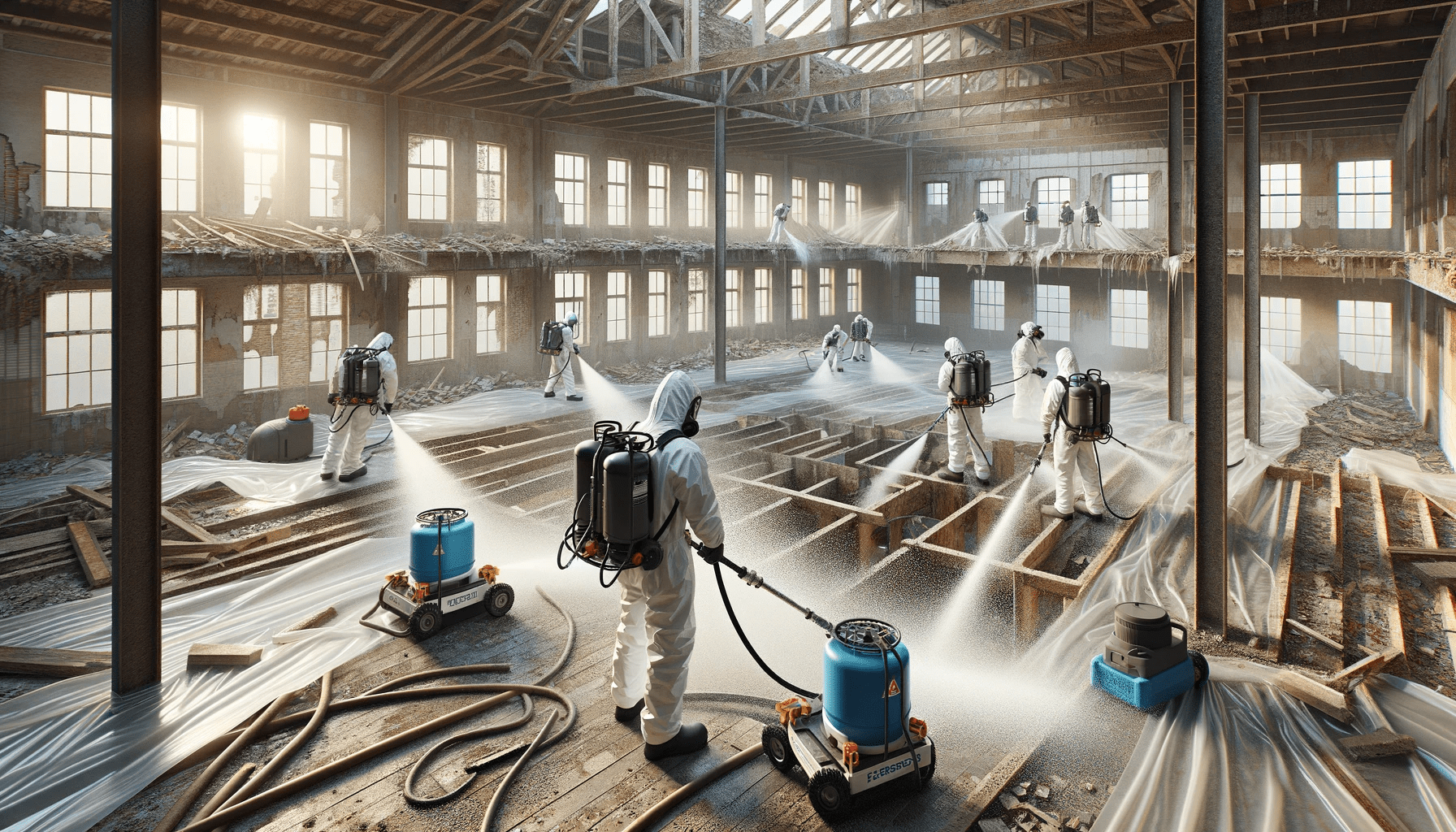
Wet Asbestos Removal Methods
Understanding the Complex History and Hazards of Asbestos
Asbestos, a term that often conjures images of safety suits and warning tapes, has a history as complex as its fibrous structure. Originally hailed as a ‘miracle mineral’ for its fire resistance and durability, asbestos found its way into numerous building materials. However, its dark side soon surfaced with the revelation of serious health risks, including lung cancer and mesothelioma, associated with asbestos exposure. These risks underpin the vital importance of safe asbestos removal, particularly within the UK, where countless older buildings still contain this hazardous material.

The Risks and Regulations Surrounding Asbestos
The Importance of Compliance with Asbestos Regulations
Understanding the risks associated with asbestos is paramount. When disturbed, asbestos releases fine fibres into the air, which, if inhaled, can cause significant health issues. The severity of these risks has led to stringent regulations governing asbestos removal. In the UK, the Control of Asbestos Regulations 2012 outlines legal requirements to manage and safely remove asbestos. Compliance with these regulations is not just a legal obligation but a moral one, ensuring the safety of workers and occupants.
The Role of Regulatory Compliance in Mitigating Asbestos Exposure
Adherence to asbestos regulations is essential to protect both workers and the public from the harmful effects of asbestos exposure. By complying with these regulations, organizations demonstrate their commitment to prioritizing health and safety above all else. Moreover, strict adherence to regulations ensures that asbestos removal procedures are conducted in a controlled manner, minimizing the risk of airborne contamination and subsequent health hazards.
Wet Asbestos Removal: A Safer Alternative
Advantages of Wet Asbestos Removal for Airborne Contamination Mitigation
Transitioning into the realm of asbestos removal methods, wet asbestos removal stands out for its emphasis on safety. This technique involves applying water to asbestos-containing materials during removal, significantly reducing the release of asbestos fibres into the air. This is in stark contrast to dry-removal methods, which can inadvertently disperse these fibres more widely, increasing health risks. The wet method’s ability to mitigate airborne contamination presents a compelling case for its widespread adoption, especially in scenarios where asbestos removal poses a high risk of fibre release.
The Process of Wet Removal
At the core of wet asbestos removal is the meticulous application of water. Before any removal begins, the asbestos-containing materials are thoroughly saturated. This saturation can be achieved through various means, such as direct spraying or a more controlled application using specialised equipment, which ensures that the fibres are weighed down and less likely to become airborne.
Equipment and Materials: The Essentials
Equipping for wet asbestos removal involves more than just a water source. The process requires specialised tools and materials, such as low-pressure sprayers, wetting agents to improve water absorption, and suitable containment measures to prevent water damage to surrounding areas. Personal Protective Equipment (PPE) is also paramount, including respirators, gloves, and protective clothing, to ensure worker safety throughout the removal process.
A Step-by-Step Guide
The actual removal of wet asbestos follows a defined sequence, starting with area isolation and signage to ensure no unauthorised access. Following this, the wetting process commences, ensuring thorough saturation. Workers then carefully remove the asbestos materials, constantly maintaining their wet state to avoid fibre release. The removed materials are then securely bagged and labelled for appropriate disposal.
Prioritising Safety in Wet Asbestos Removal
Ensuring Safety and Efficacy in Wet Asbestos Removal
The removal of asbestos, particularly through wet methods, is as much about safety as it is about efficacy. This section highlights the crucial safety measures and best practices that govern wet asbestos removal, ensuring not only the effectiveness of the procedure but also the wellbeing of those involved.
Essential Safety Gear and Precautions
When dealing with asbestos, personal protective equipment (PPE) is non-negotiable. For wet asbestos removal, this includes impermeable gloves, respirators fitted with appropriate filters, and full-body coveralls. This gear ensures that workers are protected from any potential exposure to asbestos fibres, even when these fibres are weighed down by the water.
Containment and Prevention Strategies
Beyond personal safety, containing the spread of asbestos within the work area is vital. Establishing a sealed containment zone prevents asbestos fibres from migrating to other parts of the building. Within this zone, using plastic sheeting and negative air pressure systems minimises the risk of fibre dispersion, ensuring that any asbestos remains confined to the area being treated.
Decontamination Procedures
A rigorous decontamination process for both workers and tools is crucial following asbestos removal. Specialised decontamination units or areas should be set up, allowing for the safe removal and disposal of protective gear and the thorough cleaning of equipment. This step is essential in preventing the spread of asbestos fibres outside the work area.
Navigating the Challenges of Wet Asbestos Removal
Tackling Accessibility and Water Damage Risks
While wet asbestos removal is a preferred method for many, it’s not without its challenges and limitations, which need to be understood and managed effectively. One of the primary challenges in wet asbestos removal is accessibility. In confined or hard-to-reach spaces, ensuring thorough wetting of asbestos materials can be difficult. Additionally, the use of water raises concerns about potential damage to surrounding materials or structures, especially in older buildings. Overcoming these challenges often requires creative problem-solving and a careful assessment of the site before beginning the removal process.
Situational Limitations
It’s also important to recognise situations where wet asbestos removal might not be the best option. In cases where water could compromise the integrity of a structure or where electrical hazards are present, alternative methods need to be considered. This highlights the importance of a thorough preliminary assessment to determine the most suitable approach for each specific case.
Looking to the Future: Innovations in Asbestos Removal
Emerging Technologies and Techniques
As we look ahead, the field of asbestos removal is poised for continued evolution, with innovations aimed at increasing safety and efficiency. Technological advancements are leading to the development of more sophisticated methods for asbestos removal. These include new types of protective equipment, advanced containment systems, and even robotic removal techniques that can minimise human exposure.
Regulatory Changes and Industry Adaptation
Changes in regulations and industry standards are also anticipated, driven by ongoing research and a deeper understanding of asbestos risks. These changes will likely require professionals in the field to adapt and adopt new practices, ensuring that asbestos removal remains not only effective but also aligned with the highest safety standards.
In conclusion, while the removal of asbestos, particularly through wet methods, presents its own set of challenges, it remains a critical task in maintaining safe environments. The key to successful asbestos removal lies in a combination of meticulous planning, strict adherence to safety protocols, and a willingness to adapt to new technologies and practices. As we continue to evolve our approaches and tools, the ultimate goal remains unchanged: to create safer spaces free from the hazards of asbestos.


